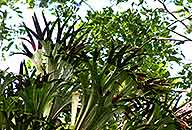Platycerium Desv.
Photo: BT. Wursten
Mozambique
Description of the genus
Large epiphytes with short rounded rhizomes and a mass of roots. Fronds strongly dimorphous. Sterile fronds clasping the host (forming 'nest leaves'), sessile, persistent, circular to oblong, entire to shallowly lobed, becoming brown and enclosing a mass of roots, old sterile fronds and plant detritus. Fertile fronds emerging from the base of the sterile fronds, simple and broadly cuneate to dichotomously divided, arching or pendulous, undersurface densely set with stellate hairs. Main veins dichotomously branched, secondary veins forming areoles. Sori spread over the undersurface of the fertile frond, confined to the lobe or the bifurcations or covering large areas, mixed with stellate paraphyses.
Derivation of name: platys: flat,referring to the broad, flat sterile fronds; keras: honeycomb,referring to the prominent venation
Comment: Known to gardeners under the name of 'staghorn ferns'
Worldwide: c. 18 species, pantropical distribution
We have 4 taxa in the database for Platycerium.
Literature
